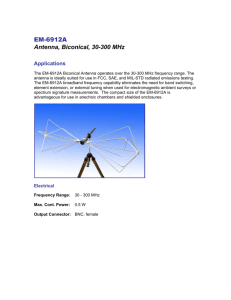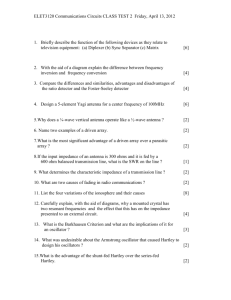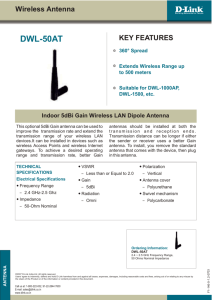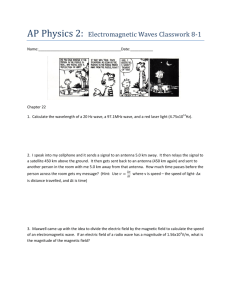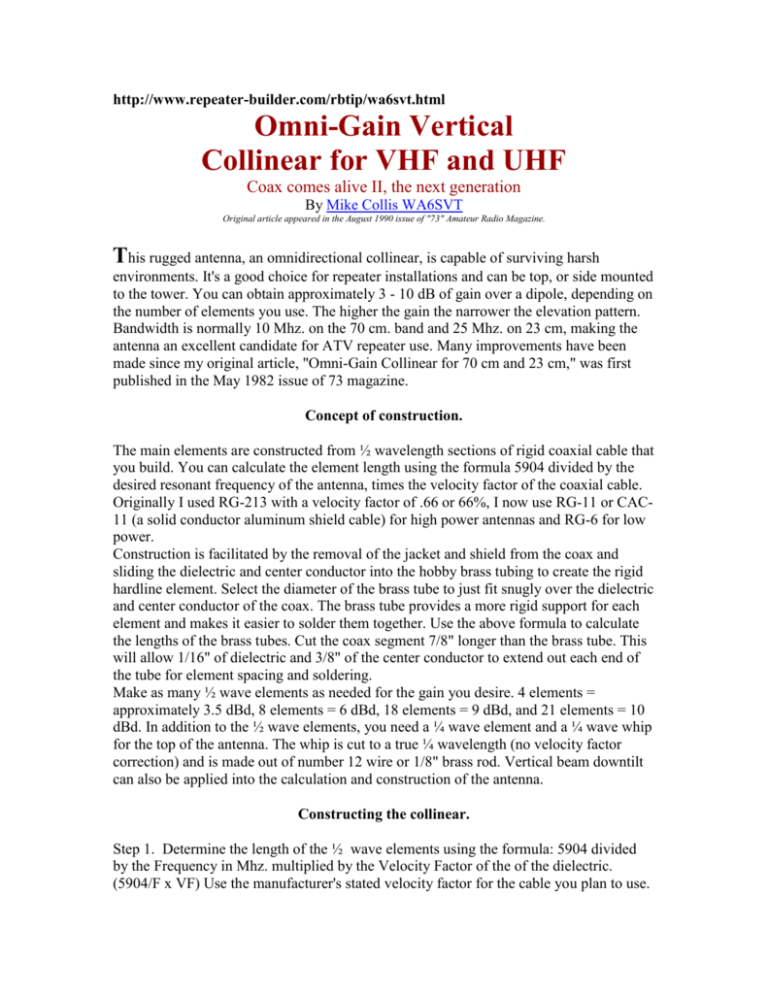
http://www.repeater-builder.com/rbtip/wa6svt.html
Omni-Gain Vertical
Collinear for VHF and UHF
Coax comes alive II, the next generation
By Mike Collis WA6SVT
Original article appeared in the August 1990 issue of "73" Amateur Radio Magazine.
This rugged antenna, an omnidirectional collinear, is capable of surviving harsh
environments. It's a good choice for repeater installations and can be top, or side mounted
to the tower. You can obtain approximately 3 - 10 dB of gain over a dipole, depending on
the number of elements you use. The higher the gain the narrower the elevation pattern.
Bandwidth is normally 10 Mhz. on the 70 cm. band and 25 Mhz. on 23 cm, making the
antenna an excellent candidate for ATV repeater use. Many improvements have been
made since my original article, "Omni-Gain Collinear for 70 cm and 23 cm," was first
published in the May 1982 issue of 73 magazine.
Concept of construction.
The main elements are constructed from ½ wavelength sections of rigid coaxial cable that
you build. You can calculate the element length using the formula 5904 divided by the
desired resonant frequency of the antenna, times the velocity factor of the coaxial cable.
Originally I used RG-213 with a velocity factor of .66 or 66%, I now use RG-11 or CAC11 (a solid conductor aluminum shield cable) for high power antennas and RG-6 for low
power.
Construction is facilitated by the removal of the jacket and shield from the coax and
sliding the dielectric and center conductor into the hobby brass tubing to create the rigid
hardline element. Select the diameter of the brass tube to just fit snugly over the dielectric
and center conductor of the coax. The brass tube provides a more rigid support for each
element and makes it easier to solder them together. Use the above formula to calculate
the lengths of the brass tubes. Cut the coax segment 7/8" longer than the brass tube. This
will allow 1/16" of dielectric and 3/8" of the center conductor to extend out each end of
the tube for element spacing and soldering.
Make as many ½ wave elements as needed for the gain you desire. 4 elements =
approximately 3.5 dBd, 8 elements = 6 dBd, 18 elements = 9 dBd, and 21 elements = 10
dBd. In addition to the ½ wave elements, you need a ¼ wave element and a ¼ wave whip
for the top of the antenna. The whip is cut to a true ¼ wavelength (no velocity factor
correction) and is made out of number 12 wire or 1/8" brass rod. Vertical beam downtilt
can also be applied into the calculation and construction of the antenna.
Constructing the collinear.
Step 1. Determine the length of the ½ wave elements using the formula: 5904 divided
by the Frequency in Mhz. multiplied by the Velocity Factor of the of the dielectric.
(5904/F x VF) Use the manufacturer's stated velocity factor for the cable you plan to use.
Solid polyethylene usually has a velocity factor of .66 or 66% while foam cable ranges
from .79 to .83.
Step 2. If you desire vertical beam downtilt, cut the elements 2% shorter, than the length
calculated in step 1, for 3° of downtilt.
See figure 6a for elevation patterns.
Step 3. Cut lengths of coax approximately 7/8" longer than the brass element tube.
Step 4. Remove the outer jacket and shield from the coax and slide the dielectric and
center conductor into the brass tube. Center the coax element in the brass tube.
Step 5. Using a knife, being careful not to nick the center conductor, cut the dielectric so
that a 1/16" sticks out past the end of the tube. This should leave about 3/8" of center
conductor exposed on each end for soldering.
See figure 1.
Step 6. Being careful to keep the whole antenna as straight as possible, solder the
prepared elements together by soldering the center conductor of each element to the outer
conductor of the next element. You will end up with transposed connected elements.
See figure 2.
Step 7. The last element is ¼ long, exactly ½ of the measured length of the ½ wave
length element. Short out the top of this section by bending over the center conductor and
soldering it to the brass tube. A ¼ wave whip is connected to the top of the shorted out ¼
wave coax element. The whip is a true ¼ wave long (no velocity factor correction) and
can be constructed out of small diameter brass rod. Make certain that the full ¼ wave
extends above the point where the coax section is shorted out by cutting the rod a bit
longer and soldering this excess to the brass tube.
See figure 3.
Step 8. The 50 ohm feedline can be any length. I use RG-213 or RG-214 coax with an
"N" connector attached . Strip off at least a half wavelength of shield on the other end of
the feedline. Leave about an inch of shield sticking out of the vinyl jacket for soldering to
the brass tube. Cut the dielectric and center conductor to expose about 3/8" of the center
conductor. Slide the half wave length or longer brass tube over the end of the exposed
feedline so that the 1" of braid can be soldered over the bottom of the brass tube.
Step 9. Make a true ¼ wave long (no velocity factor correction) decoupling sleeve out of
a piece of ¾" brass tubing. Using some excess shield material, or some other acceptable
manner, solder the decoupling sleeve to the feedline outer conductor at a point exactly ¼
wavelength down from where the feedline attaches to the first ½ wave element.
See figure 4.
Step 10. Attach the exposed end of the feedline to the bottom of the collinear by
connecting the center conductor of the feedline to the outer conductor of the antenna and
vice versa.
Step 11. Make some styrofoam spacers to slip over some of the antenna elements. Cut
the spacers for a diameter slightly less than the inside diameter of the radome pipe. Space
them out to evenly support the antenna when you place it in the fiberglass or PVC
radome cover. The spacers should be attached to the midpoint of the element with a small
amount of epoxy or hot glue.
See figure 5.
Step 12. Cut a piece of fiberglass or PVC pipe so that 18 inches or more extend past the
top of the whip and also below the decoupling sleeve. Slide the antenna carefully into the
pipe and cap off the top. Drill two holes near the bottom of the radome pipe and pass a
piece of insulated wire through and around the feedline below the decoupling sleeve to
support the weight of the antenna. Twist the wire until it holds the feedline tightly against
the radome cover. Place another styrofoam spacer on the very end of the pipe and glue it
in place. Make sure to poke a few small holes or notches in the spacer to allow the end of
the antenna to breathe. You are ready to fire up the your collinear!
See figure 7.
Tune up and Operation.
Find a clear area, free of obstructions. Mount the antenna to a pole making sure to clamp
the antenna to the mast at a point below the decoupling sleeve area. Attach a wattmeter or
SWR bridge to the antenna. If the SWR is over 1.5:1 you can adjust the decoupling
sleeve slightly up or down for the best reading. If you have designed the antenna for
downtilt you can check it by observing the signal strength of a nearby repeater. Tilt the
angle of the antenna until the signal peaks, then measure the angle with a protractor. If
the angle checks ok you are ready to mount the antenna to your tower!
Mounting your collinear on top of your tower will give you an omni-directional pattern.
If you desire a Cardoid pattern, or if your only option is side mounting, you can mount
the antenna to the side of the tower with one or two brackets. Make sure the bottom
support is attached to the antenna below the decoupling sleeve, and that the top support is
mounted 18" or more above the top of the whip. Mounting the collinear ¼ wavelength
away from the side of the tower will give you about a 2 dB increase in the frontal lobe of
the pattern. A spacing of a ½ wavelength will increase the signal 2 dB at 90° angles from
the frontal lobe. Both patterns give a null in the direction of the tower.
See figure 6b. This antenna should handle the worst Mother Nature can through at it. It
has performed admirably at the ATV repeater site on 5670' Santiago Peak for many
seasons. Mounted on the tower it blends right in with the commercial commercial
antenna installations.
Mike Collis WA6SVT is active on amateur television (ATV) in the Los Angeles area and
works as a communications supervisor for San Bernadino County. You may reach him at
P.O. Box 1549 Crestline CA 92325 or at WA6SVT@aol.com
Kevin Custer has also built several versions of this antenna using this article and feels out
of all of the collinear construction articles this is the best. Versions include 2M, 220, and
440 models for FM voice repeaters.
Click here for Kevin's variations, and construction ideas.
Visitors since October 10 1998
Counter by Rapid Axcess
Back to Home
Original Copyright © August 1990 "73" Magazine and originating author Mike Collis
WA6SVT. All Rights Reserved.
HTML Copyright © Sunday August 23 1998 @ 11:04 PM
Kevin Custer W3KKC All Rights Reserved.
http://www.repeater-builder.com/rbtip/uhfcoll.html
Kevin's variations and construction ideas
on the WA6SVT Omnidirectional Coaxial Collinear
By Kevin Custer W3KKC
As stated earlier, I have been successful in building several versions of the WA6SVT
collinear. I also have a few ideas that I think are worthy of presenting to you here. These
ideas are not meant to demean Mike Collis' construction principals, they are presented
here to give more ideas to the builder and allow other construction possibilities from
available materials.
Although Mike makes no reference to using this antenna on 2 meters or VHF, this article
provides the approximate construction practice that Phelps Dodge (now Cellwave) uses
to construct the all famous Stationmaster and Super Stationmaster style of fiberglass
radome vertical omni's for VHF and UHF. I have used this article to construct antennas
for 2M, 220, and 440 voice repeaters. They will also work well on digital and ATV.
Now onto my ideas, facts, and past construction practices for the collinear.
Step 1, and the "Concept of construction" states the calculation process of the brass
element length. You might think from this calculation that the length of the antenna can
be shorter by using solid dielectric instead of foam, however, remember it's not the
number of elements that determines the gain, it's the overall length of the collinear. As
Mike had stated, in the Concept, that he now uses RG-11 and RG-6 which is a foam
dielectric cable. The use of foam cable allows a physically longer antenna using the same
number of elements in design. Also, since this antenna is a radiating piece of coaxial
feedline, the concept of losses should also be taken into consideration. Why? Solid
dielectric cable has more loss than foam, and losses increase with frequency.
Remember these facts:
Since this antenna is end fed, the available signal for radiation is the greatest at the
bottom of the antenna and diminishes as the signal goes toward the top. Why? As the
bottom element receives the signal, some of the signal is lost to the next element because
some of the energy was radiated (this is an antenna) and now is not available to be fed
into the next element. Also, some of the energy was lost due to dielectric losses in the
element, just as a piece of feedline has loss. This loss goes up in heat, and is not available
for rf radiation from the antenna. This is why Mike uses different sizes of cable for high
and low power antennas. The larger the element, the better the ability to dissipate heat.
The use of solid dielectric cable on 2M and 220 is acceptable, however you may want to
consider a foam type for UHF and beyond.
Step 2 suggests that you can build vertical beam downtilt into the antenna. When downtilt
is desired you simply cut the element 2% shorter than the calculated length. This then
makes the antennas resonant frequency higher than the operating frequency. Does this
create SWR? Yes, and this can be trimmed somewhat with the adjustment of the
decoupling sleeve. However, the suggested method of attaching the sleeve makes it
difficult to adjust the sleeve easily. A better way of attaching the sleeve, to the brass
feedline section, is to use a washer soldered into the top of the decoupling sleeve and
solder a piece of brass tubing, one size larger than used to build the elements, into the
washer allowing an inch or so inside the sleeve and above the washer. This will allow
you to slide the decoupling sleeve, to the correct position, easily. When you are satisfied
on the final position of the sleeve after tuning, simply solder the two brass tubes together
at the upper joint. On UHF antennas I use a commode fill tube for the decoupling sleeve,
available at the local hardware store and a U.S. twenty five cent piece fits into the tube
perfectly. This is a cheap way of making a solderable washer, as it will only cost you a
quarter. Make certain to use an older one in the 60's or 70's as not to get the newer cheap
unsolderable aluminum ones.
The article suggests the use of hobby brass tubing in the construction of the antenna. I use
a brand of brass tubing manufactured by K&S Engineering from Chicago Ill. This
company makes brass tube in sizes from 1/16" to 5/8" in 1 foot and 3 foot lengths. Some
RG-8 and RG-213 guts will sleeve into the 5/16" tubing very nicely. The 11/32" size can
be used for the decoupling sleeve adjustment.
Step 7 suggests that a quarter wave whip be placed on top of the last coax element. I
simply prepare the last element by folding the center conductor over the top of the brass
tube and then I cut a piece of brass tube that is one size larger than the elements and
slightly longer than the quarter wavelength. Slot the end of the tube to allow the center
conductor to be folded over while sleeving a ¼" of the larger tube over the last element.
Ensure that a full ¼ wavelength of open tube extends past the end of the shorted ¼ wave
coax element. Solder the tube and center conductor to the top of the last element. This
makes a more rigid top element that can be supported from the top of the fiberglass or
PVC pipe. If you are crafty, you can build the last ¼ coax element and the top ¼ wave
whip element all from one piece of tubing. Simply drill a small hole in the side of the
tube to allow the center conductor to be pulled through the side and solder. The hole will
be drilled at the intersection as if two separate elements. Ensure that the dielectric extends
to the hole and a full ¼ wave in air exists above the hole. Another method for the top ¼
wave element is to use a piece of brass all-thread. You can solder the all-thread
paralleling the full length of the last ¼ wavelength coax element. Allow the full ¼
wavelength whip to extend past the shorted end of the last element. This practice will
allow you to use a PVC pipe cap to carry the weight of the antenna. Drill the center of the
cap and allow the brass all-thread to extend past the end of the radome. Solder the brass
all-thread rod to the last element before you stuff the dielectric and center conductor into
the element, as not to melt the last coax element with too much heat. Place a brass or
stainless nut above the pipe cap to allow the all-thread bolt to carry the weight of the
antenna. If you have the antenna attached at the bottom, Do Not string the elements too
tight, with the nut, as this will cause the elements to break at the joints. Use an "O" ring
or some silicon RTV to weatherproof the area at the top where the brass threads come
out.
Steps 11 and 12 suggest methods of mounting the antenna into PVC or fiberglass pipe. I
have successfully dismantled old commercial fiberglass antennas and used the radome for
my antenna project. This makes an excellent home for the new antenna. Some of these
style antennas have a large brass top that is pointed and secured to the top of the
fiberglass. I have drilled the brass cap to allow the top ¼ wave tube whip to be soldered
into the cap. This allows the weight of the antenna to hang, instead of the weight pushing
to the bottom. Also, the large aluminum sleeve that the commercial antennas have for
mounting to the mast is actually the decoupling sleeve for the antenna. This usually has
three allen head screws in the top to secure the inside of the antenna to the sleeve. I have
been successful in saving this part of the commercial antenna and adapting it
mechanically to the homemade collinear. Commercial antenna construction differs from
one manufacturer to another and this may not be a possibility with all types. The
stationmaster uses a matching scheme in the bottom of the antenna that no one seems to
understand. I have a drawing of a stationmaster bottom and the machine work and
materials are fabulous, but I do not understand their function or purpose. When I build an
antenna, using the stationmaster radome, I gut the bottom machined section and apply the
parts to the new antenna design. The most important part of the antenna, in my opinion, is
the decoupling sleeve. In the stationmaster, this is also the bottom aluminum mounting
sleeve. Usually ground radials are attached to the top of this sleeve. Ground radials, on a
sleeve decoupled antenna, do nothing as the sleeve is far better to decouple the feedline
than radials anyway. Ground radials will also radiate signal in the horizontal plane taking
away from the clean vertical pattern and elevating the brewster angle. I simply don't use
them. I have built antennas using the sleeve as in the article and then attaching this sleeve
to the stationmaster sleeve connecting both sleeves together at the top. My theory on this
practice comes from looking at a C-Band satellite feedhorn. If you look at the feedhorn as
a choke, which it is, you can visualize several decoupling sleeves one inside the other all
connected at the top. Are two sleeves better than one? Good question, however I have
had excellent results with this practice, and satellite tv feedhorns have more than one ring
(sleeve.) I simply take the large top "washer" that has the holes drilled and tapped for the
3 screws and desolder all from it. I then drill the washer out to allow the new decoupling
sleeve to be inserted. I solder the washer to the top of the new decoupling sleeve. This
allows you to thread the antenna into the radome and secure the washer to the original
sleeve with the 3 recessed screws. The local Motorola shop usually has a few old
Stationmaster types that were removed due to being broken internally and no longer
duplex well. I buy these antennas for little to nothing and use the radome for my own use.
Jim Hartzell WA3UQD offers these suggestions in testing the antenna.
Mounting larger arrays near the ground (less than 1 1/2 times the length of the antenna)
causes a false reading of the SWR, it reads higher. If the antenna is tested in the
horizontal position it need only be greater than 1 wavelength above the ground on nonmetallic supports, the area still must be clear of other objects.
If you have enjoyed this article and/or these construction notes, or if you have any
questions or comments about this antenna or construction project, Please email me using
the link below.
I may take the time to do more quality construction projects in the future.
Copyright © September 1998
Back to the construction article
Back to Home
Kevin K. Custer W3KKC

